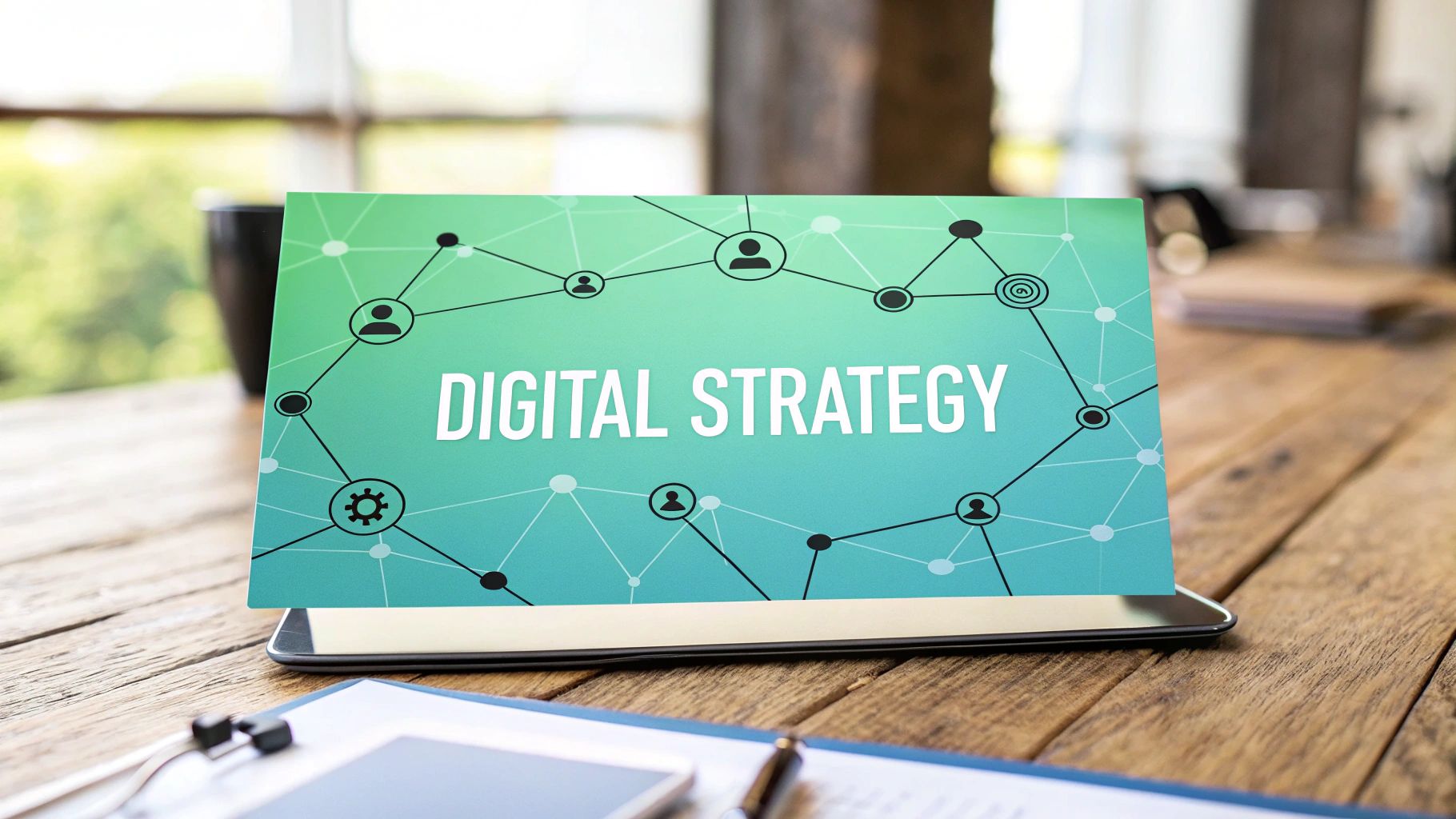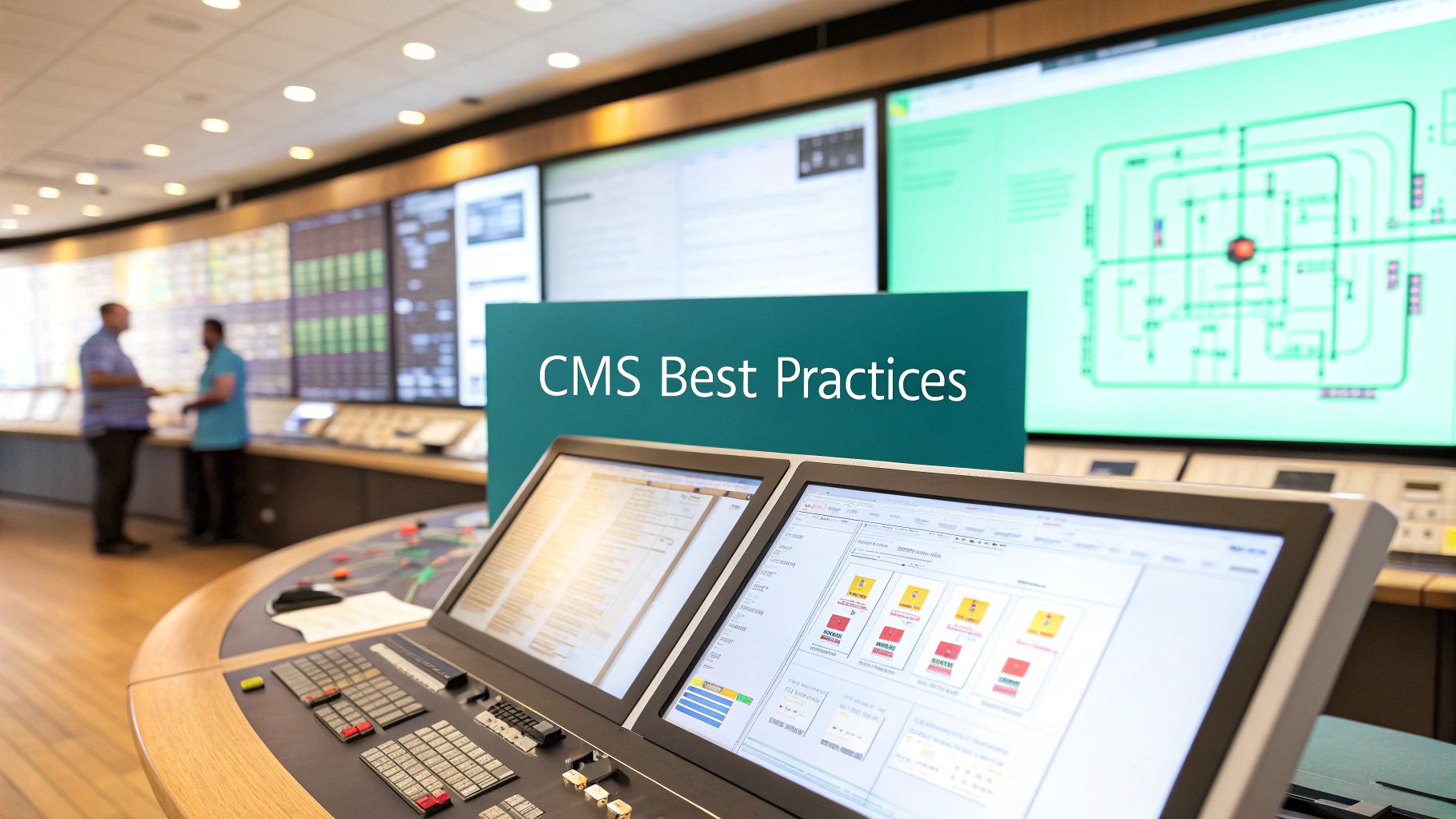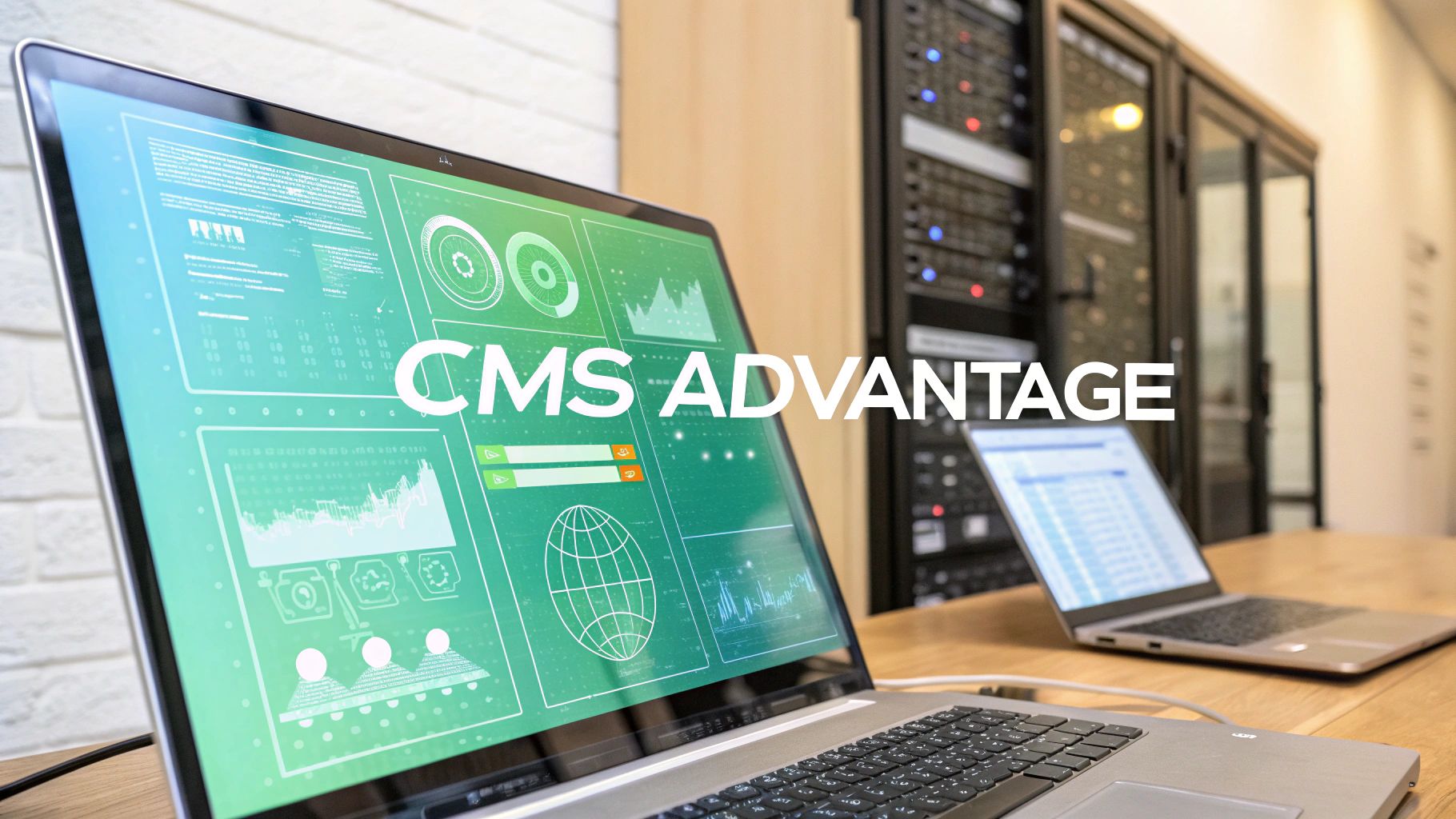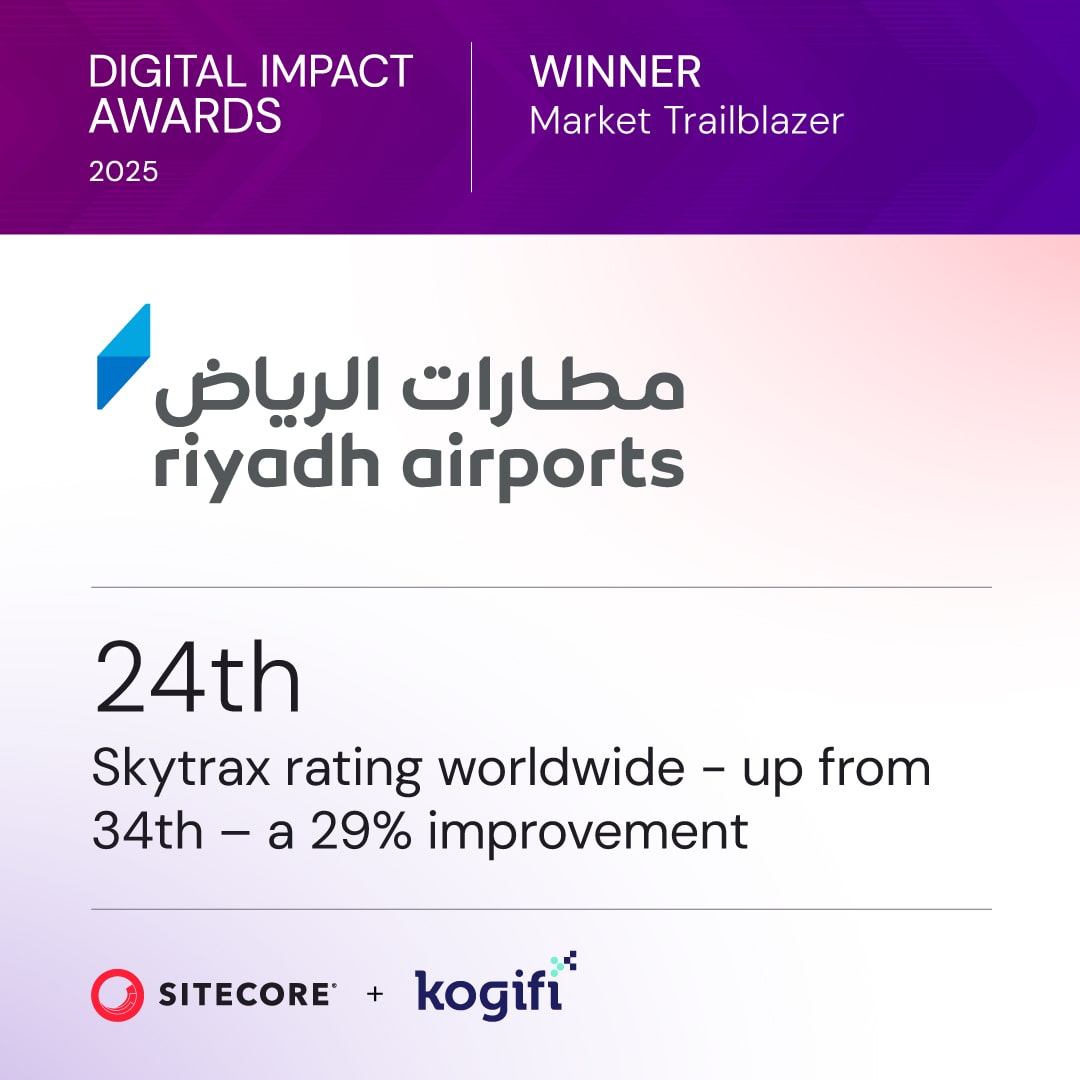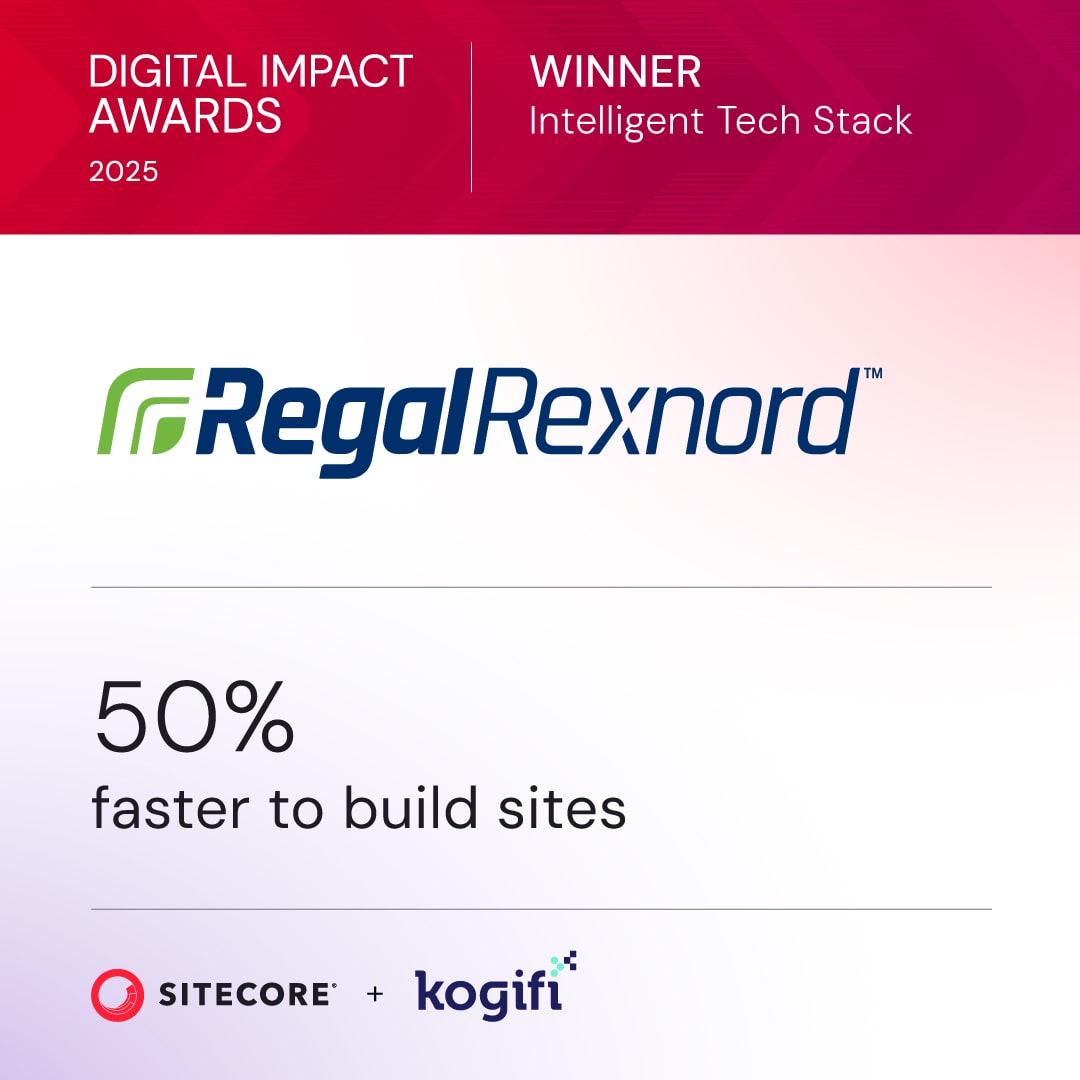At its core, a digital transformation strategy is your detailed roadmap for reinventing the business in a digital-first world. It’s not just about buying new tech; it’s a fundamental shift in how you operate and deliver value to customers by getting your people, processes, and technology all pulling in the same direction.
Decoding Digital Transformation Strategy
Think of a digital transformation strategy as the architectural blueprint for a modern business. A building needs a strong foundation, right? Well, a business needs a clear strategy to guide its technological and cultural evolution. Without this plan, technology investments often end up isolated, inefficient, and completely disconnected from actual business goals.
This strategy goes far beyond just installing new software. It demands a complete reimagining of the customer journey, operational workflows, and even the company culture. A retailer, for instance, might implement a Sitecore Digital Experience Platform not just to sell online, but to build a unified customer profile that delivers personalized offers whether someone is on their app, browsing the website, or walking into a physical store. To see how these tools work, you can learn more about what a digital experience platform is and what it does.
The Four Pillars of a Successful Strategy
Every robust strategy is built on four interconnected pillars. You have to address each one to ensure a balanced and sustainable transformation. It’s a common pitfall to focus only on the technology while forgetting the human and procedural elements that are absolutely critical for success.
A holistic digital transformation strategy is built on four essential pillars. Each one supports the others, creating a balanced approach that prevents teams from focusing too heavily on technology while neglecting the human and operational sides of change.
The Four Pillars of a Digital Transformation Strategy
By addressing each of these pillars, you create a comprehensive framework that connects your vision to tangible actions and drives real, measurable results.
The infographic below shows how a clear strategic vision, supported by these key pillars, leads to the business outcomes you’re aiming for.
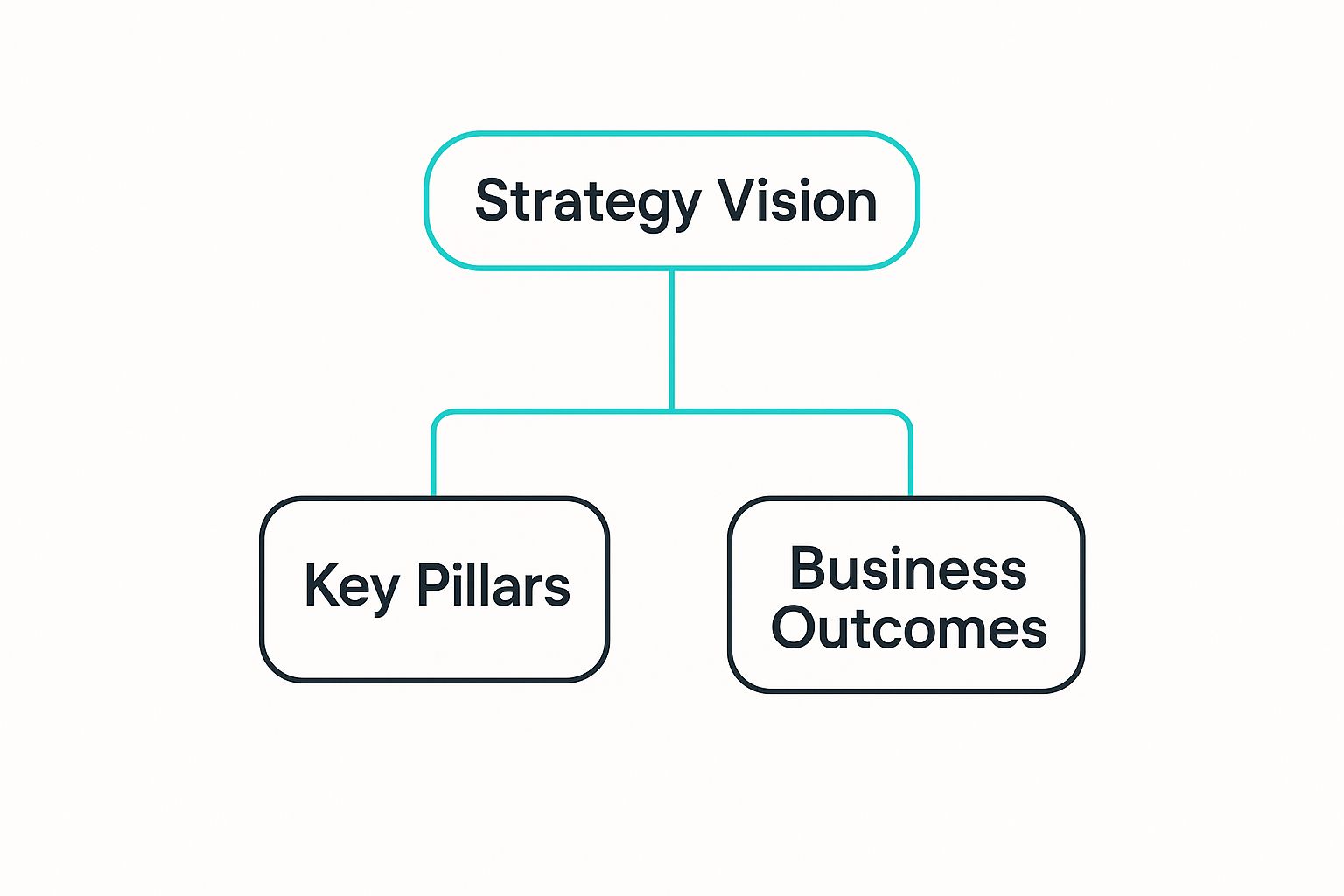
This visual makes it clear: true transformation starts with a high-level vision, which is then brought to life through these foundational pillars to generate real results.
But executing this vision is a huge challenge. Globally, the success rate for these initiatives hovers around a mere 35%, even with massive investments. Organizations that follow comprehensive best practices, however, can achieve success rates three times higher. This just goes to show how critical strategic planning really is. For a deeper look at the core concepts, you might find this article on What Is Digital Transformation Strategy Today to be a helpful resource.
Why Your Business Needs a Digital Strategy Now

In today's market, having a formal digital transformation strategy isn't a luxury—it’s a matter of survival. Without a clear plan, businesses are simply reacting to change, constantly trying to catch up as customer expectations and markets shift beneath their feet.
A well-defined strategy is what separates the leaders from the followers. It’s the difference between being disrupted and being the one doing the disrupting.
This isn’t just about buying the latest software. It's about fundamentally rethinking how your business creates and delivers value. For example, a company might use Sitecore's composable DXP not just to launch a new website, but to orchestrate a seamless customer journey across web, mobile, and even in-store interactions. That's modern competitive advantage in a nutshell.
Driving Superior Customer Experiences
Today’s customers don’t just want seamless and personalized interactions; they expect them. A smart digital strategy is your blueprint for meeting—and exceeding—those expectations. By integrating tools like a Customer Data Platform (CDP) and personalization engines from the Sitecore ecosystem, you can finally move beyond guesswork.
This is how you get to true one-to-one marketing. Imagine a visitor returning to your e-commerce site. Instead of seeing a generic homepage, they’re greeted with product recommendations based on their past browsing and abandoned carts, all powered by a platform like Sitecore Personalize.
This isn't just a neat trick; it's a direct line to building loyalty and boosting revenue. You transform the customer relationship from a series of disconnected transactions into a continuous, engaging conversation.
Fostering Agility and Operational Efficiency
A solid digital strategy doesn't just face outward; it’s also about cleaning up your own house. Legacy processes are often slow, manual, and riddled with bottlenecks. Digital transformation tackles these inefficiencies head-on, automating workflows and breaking down internal barriers.
For instance, a tool like SharePoint can become a central knowledge hub, ensuring that your sales, marketing, and support teams are all working from the same playbook. No more data silos, just faster, more informed decisions across the board.
By streamlining internal processes, organizations free up valuable employee time to focus on high-impact activities like innovation and customer service, rather than getting bogged down in repetitive administrative tasks. This operational agility is critical for outmaneuvering competitors in a fast-paced environment.
This internal alignment is crucial. When your teams are empowered with the right tools and clear processes, the entire organization becomes more resilient and ready to adapt. Following established guidelines is key here; for a deeper dive, check out our guide on digital transformation best practices.
The business outcomes are undeniable. A focused strategy translates directly into a stronger market position, increased revenue, and a competitive advantage that’s built to last. It prepares your business not just for today's challenges, but for tomorrow's opportunities.
The Technology Powering Modern Digital Transformation
A digital transformation strategy isn't just a document; it’s brought to life by the technology you choose. This tech stack is the engine that powers everything from personalized customer experiences to smoother internal operations. Getting this foundational decision right dictates what you can—and can't—do for years to come.
At the heart of any modern stack is the Digital Experience Platform (DXP). Think of a DXP as the central nervous system for all your customer interactions. It’s the place where your content, data, and commerce tools all come together to create one seamless journey, no matter if someone is on your website, using your app, or talking to a smart device.
The Sitecore Ecosystem as the Transformation Engine
When it comes to executing a serious digital transformation strategy, Sitecore has cemented its place as a top choice. Its family of products is built to manage the entire customer lifecycle, going far beyond what a simple Content Management System (CMS) can do and offering a fully connected ecosystem.
The star of the show is Sitecore XM Cloud, a cloud-native, SaaS-based DXP. Its real power lies in its composable, headless architecture, which gives you incredible flexibility. This means you can hand-pick the best tools for specific jobs—like a third-party e-commerce engine or a specialized analytics tool—and plug them right into a single, unified platform. You’re not stuck with a rigid, all-in-one suite. Instead, you build a tech stack that perfectly fits your business. For anyone weighing their options, understanding the differences between the best digital experience platforms is a critical first step.
To get that coveted unified view of your customer, you need specialized tools that talk to each other and break down data silos. The Sitecore ecosystem is designed for this, with components that work in harmony:
- Sitecore Content Hub: This is so much more than a digital asset manager. It’s a central command for content planning, creation, and distribution. It ensures every team, from marketing to product, is working from the same playbook.
- Sitecore Search: An AI-powered tool that delivers smart, personalized search results on your websites and apps. It helps people find what they need faster, which dramatically improves their experience.
- Sitecore CDP (Customer Data Platform): This is where the magic of personalization happens. It collects and stitches together customer data from every single touchpoint—both online and off—to create a single, rich profile that fuels real-time personalization on a massive scale.
A composable DXP gives you the agility to roll with the punches. Instead of being locked into one vendor's roadmap, you can swap components in and out as new technologies pop up or your business needs change. It’s all about future-proofing your investment.
SharePoint Empowering the Internal Transformation
Mastering the external customer experience with Sitecore is only half the battle. A true digital transformation also requires streamlining how your own teams work. This is where SharePoint becomes an essential piece of the puzzle. It acts as the internal backbone for collaboration and knowledge sharing, making sure everyone in the organization is moving in the same direction.
If Sitecore is your polished, customer-facing storefront, SharePoint is the well-organized warehouse and efficient back office that makes it all possible.
Investing in these technologies is no longer a "nice-to-have." The push for digital transformation is accelerating, with 75% of digital leaders worldwide planning to increase their budgets in 2025. Cloud-native platforms (72% adoption) and Infrastructure-as-a-Service (71% adoption) are leading the charge, proving they are key to building scalable and agile operations. Success now hinges on integrating cloud infrastructure with smart AI and sticking to a clear strategic roadmap. You can discover more about the 2025 state of digital transformation to see where things are headed.
SharePoint supports this internal alignment in a few crucial ways:
- Seamless Collaboration: It creates shared digital workspaces where teams can co-author documents, track project timelines, and communicate without friction. This breaks down the departmental silos that slow everything down.
- Centralized Knowledge Sharing: It becomes the single source of truth for company policies, training guides, and best practices. Everyone gets access to the information they need to excel.
- Automated Workflows: By automating routine tasks like document approvals or new hire onboarding, SharePoint frees people from tedious manual work. They can then focus on more strategic, high-impact activities.
Together, the Sitecore DXP and SharePoint create a complete technology framework. One masters the customer journey to drive growth and loyalty, while the other empowers the internal teams who bring that vision to life.
Building Your Sitecore and SharePoint Framework

A great digital transformation strategy is more than just an idea—it’s an actionable plan. The right technology brings that plan to life. This framework breaks the journey into four distinct phases, giving you a structured way to get from where you are to where you need to be.
Each phase builds on the one before it, creating a logical path from initial discovery to long-term success. We’re not just talking theory here. We’ll map specific tools from the Sitecore and SharePoint portfolios to solve real problems at each stage. This is how you turn big goals into measurable wins.
Phase 1: Assessment and Discovery
Before you can chart a course, you have to know your starting point. The Assessment and Discovery phase is all about a deep-dive audit of your current tech, processes, and customer experiences. The goal is to get a clear, data-driven picture of what’s working and what isn’t.
This isn’t the time for guesswork. You need to identify the real pain points, bottlenecks, and hidden opportunities. Without this solid foundation, the rest of your strategy is just wishful thinking.
How Technology Helps
- Sitecore Analytics: Put Sitecore’s analytics tools to work auditing your current digital footprint. You can track user behavior, see where customers drop off, and find out which content is falling flat. This gives you a hard, evidence-based look at what needs fixing first.
- SharePoint for Process Auditing: Use SharePoint lists and diagrams to map out your internal workflows. Survey your teams and document how they actually collaborate. This is a surefire way to uncover operational snags and find clear opportunities for automation.
Phase 2: Vision and Goal Setting
Once you know where you stand, it's time to decide where you're going. The Vision and Goal Setting phase is where you translate big business ambitions into specific, measurable objectives. This is where you answer the most important question: "What are we actually trying to achieve?"
A strong vision acts as a North Star for every decision that follows. It gets everyone—from the C-suite to the front lines—pulling in the same direction.
This is about moving past vague goals like "improving the customer experience." A powerful vision sets a concrete target, like: "Increase customer lifetime value by 15% in two years by delivering personalized, real-time offers across all our digital channels."
How Technology Helps
- Sitecore Personalize: This tool is perfect for making your one-to-one marketing vision tangible. You can set specific goals, like boosting conversion rates for a key customer segment, and then use its A/B testing features to model exactly how you’ll get there.
- SharePoint for Vision Communication: Turn a SharePoint site into the central hub for your transformation vision. It can house key documents, stakeholder presentations, and KPI dashboards to keep the entire organization aligned and up to speed.
Phase 3: Roadmap and Prioritization
You have a clear destination. Now, how do you get there? The Roadmap and Prioritization phase is about breaking your vision down into manageable projects and then sequencing them based on impact and effort. You can't do everything at once.
The key is to focus on quick wins and high-impact initiatives first. This builds momentum and shows tangible results early on, which is essential for keeping everyone bought into a long-term transformation. A well-managed roadmap is also a cornerstone of effective enterprise content management solutions.
How Technology Helps
- Sitecore Content Hub for Project Planning: Use Content Hub's project management tools to map out your content strategy. You can plan content creation, assign tasks, and manage workflows for all the new website sections or marketing campaigns on your roadmap.
- SharePoint for Project Management: Set up a dedicated SharePoint project site to manage the entire implementation. Track your milestones, store project documents, and keep the lines of communication open between technical and business teams.
Phase 4: Governance and Optimization
Finally, a digital transformation isn't a "one-and-done" project. It’s an ongoing commitment to getting better. The Governance and Optimization phase is where you establish the roles and processes needed to keep the momentum going, measure results, and constantly refine your approach.
This final stage creates a culture of continuous improvement, making agility a core part of how your company operates.
How Technology Helps
- Sitecore Analytics and CDP: Keep a close eye on your KPIs with Sitecore’s analytics. The Customer Data Platform (CDP) will give you ongoing insights into customer behavior, allowing you to tweak personalization rules and optimize campaigns on the fly.
- SharePoint for Governance Documentation: Use a SharePoint library as the single source of truth for all your digital governance policies. This is where you’ll store content style guides, security protocols, and compliance standards, ensuring everything stays consistent as your digital presence grows.
Putting these tools to work within a structured framework gives you a practical, step-by-step guide for your transformation. The table below shows exactly how Sitecore and SharePoint align with each phase, providing a clear blueprint for your team.
Sitecore & SharePoint Roles in Your Transformation Framework
By mapping the right tool to the right job at the right time, you move from abstract strategy to concrete execution. This alignment ensures that your technology investments are directly driving the business outcomes you're aiming for.
Sidestepping Common Transformation Roadblocks
Even the sharpest digital transformation strategy is going to hit some turbulence. The trick is to see these common challenges coming so you can navigate them without losing momentum and stalling out. This journey often unearths deep-seated issues that a new piece of tech, on its own, just can't fix.
You’ll almost certainly run into obstacles like internal resistance, stubborn data silos, and the limitations of aging legacy systems. A clear vision from the top is great, but without the right tools and a solid plan for managing change, that vision rarely makes it to the people doing the actual work.
Tearing Down Data Silos with Sitecore
One of the most persistent roadblocks you'll face is the data silo. When customer information is trapped in separate systems—one for e-commerce, another for marketing, and a third for your service desk—it’s impossible to get a complete picture of your customer. This mess is the number one reason why efforts to create personalized experiences fall flat.
A unified Digital Experience Platform (DXP) like Sitecore is built to solve this exact problem. By bringing tools like the Sitecore Customer Data Platform (CDP) into the mix, you can finally pull data from every single touchpoint into one place.
The goal here is simple: create a single, authoritative profile for every customer. This unified view lets you see their entire journey—from their first click on your site to their most recent purchase—so you can deliver truly consistent and personal interactions everywhere.
This isn't just about plugging in new software; it's a strategic move. It forces the walls between departments to come down, making marketing, sales, and service teams all work from the same playbook. The result? A much more cohesive and effective way to engage with your customers.
Building Team Buy-In with SharePoint
Let's be honest, resistance to change usually comes from fear and confusion. If your team doesn't understand why things are changing or how new tools will make their jobs better, they’re not going to jump on board. This is where a tool like SharePoint becomes your secret weapon for change management.
Think of SharePoint as the central hub for your entire transformation. It gives you the scaffolding you need to get everyone aligned and to support your teams as they adapt.
- A Central Hub for Communication: Set up a dedicated SharePoint site just for the transformation project. Use it to share the leadership's vision, post project timelines, and give regular updates. Keeping everyone in the loop is half the battle.
- Training and Onboarding Resources: You can host all your training materials, how-to videos, and best-practice guides right on SharePoint. This creates a self-service resource that lets people learn the new systems at their own pace, which cuts down on anxiety and gets them using the tools faster.
- A Place for Feedback and Collaboration: Use SharePoint's forums and lists to actively gather feedback. This creates a genuine two-way conversation. When people feel like they're being heard and are part of the process, they're much less likely to resist the changes being made.
While technology gives you the tools, you can't forget the human side of the equation. A huge challenge across the board is the talent shortage; a staggering nine out of ten organizations say they don't have the skills needed to pull off their digital projects. On top of that, economic uncertainty is a real constraint for 23% of organizations. It's interesting to note the gap in perspective, too—42% of C-suite executives expect to see ROI in six months or less, a rate double that of line-level managers. You can dig into more insights on digital transformation challenges to understand these dynamics.
By using platforms like SharePoint to upskill and align the teams you already have, you can tackle this skills gap head-on and build the internal muscle needed for a smooth and successful transformation.
How to Measure Your Digital Transformation ROI
A slick new website or a fancy internal portal is great, but if it isn't delivering a real return on investment, it's just a vanity project. To justify the time, effort, and budget you've poured into your transformation, you need to prove its worth with cold, hard numbers. That means looking past surface-level metrics like website traffic and focusing on the Key Performance Indicators (KPIs) that actually move the needle.
Measuring ROI is all about drawing a straight line from your technology investments to your core business goals. Are you improving customer value? Cutting operational costs? Making your teams more productive? Let's break down how to track it.

Defining Customer-Facing KPIs with Sitecore
When your transformation is customer-centric, your metrics have to be, too. This is where a powerful tool like the Sitecore Digital Experience Platform (DXP) comes in. Its built-in analytics are designed specifically to show you how changes in personalization and content are impacting what users actually do.
Here are a few of the most important KPIs to keep an eye on in Sitecore:
- Customer Lifetime Value (CLV): This is the ultimate report card for a long-term relationship. Sitecore’s analytics can track repeat purchases and engagement over time, showing you exactly how your personalization efforts are nurturing your most valuable customers.
- Conversion Rate Optimization: With Sitecore’s A/B testing and personalization tools, you can directly attribute a jump in conversions—like form fills or completed purchases—to specific digital initiatives you've launched. No more guesswork.
- Personalization Impact: You can finally answer the question, "Is this personalization thing actually working?" Track how tailored experiences influence metrics like average order value or time on site. This gives you direct proof of the financial benefit of creating better customer journeys.
The results can be dramatic. Just look at a case study on tailored digital transformation boosting qualified leads for a real-world example of clear, measurable ROI.
Measuring Internal Efficiency with SharePoint
The other half of the ROI story happens inside your own walls. A tool like SharePoint is fantastic for boosting operational efficiency and employee productivity, and its reporting features let you put a number on those improvements.
Your goal is to show how technology is making the organization faster, smarter, and more cost-effective from the inside out. This proves that transformation impacts more than just the marketing department.
Here are the key internal KPIs to track with SharePoint:
- Operational Cost Reduction: By automating once-manual workflows in SharePoint, you can literally calculate the hours saved. Those saved hours translate directly into lower operational costs.
- Employee Productivity Gains: How much faster are projects getting done? How much time are people saving now that they aren't digging through a dozen different folders for one document? Measure it.
- Internal Adoption Rates: Use SharePoint’s usage analytics to see how many employees are actually using the new intranet or collaboration sites. High adoption proves you have enterprise-wide buy-in.
By creating a performance dashboard that pulls data from both Sitecore and SharePoint, you can paint a complete picture of your ROI. This connects your external customer wins directly to your internal operational excellence, giving you a powerful, data-backed story to tell.
Frequently Asked Questions
Jumping into a digital transformation strategy can feel complex, and it’s natural to have questions. Here are some clear answers to the most common ones we hear, designed to give you a solid footing before you dive in.
What Is the First Step in a Digital Transformation Strategy?
The very first step, without question, is assessment. You simply can't map out where you're going until you know exactly where you are. This means taking a hard, honest look at your current state.
It involves a deep dive into your existing tech stack, tracing your current business processes from start to finish, and gathering real data on how your customers behave. For instance, you might use Sitecore Analytics to pinpoint where users are dropping off your website, or use SharePoint to document clunky internal workflows. This discovery phase gives you a data-driven baseline, turning guesswork into a concrete starting point.
How Do Sitecore and SharePoint Support Transformation Differently?
While they both play crucial roles, Sitecore and SharePoint serve two very different—yet complementary—purposes in a transformation strategy.
Sitecore is your external-facing platform. Its entire focus is on mastering the customer journey. Think of it as the engine powering your personalized marketing, e-commerce experiences, and content delivery. It’s what you use to win over customers and keep them loyal.
SharePoint, on the other hand, is your internal-facing platform. It’s all about empowering your employees and optimizing how work gets done. It acts as the central nervous system for your team, handling collaboration, knowledge sharing, and workflow automation to make sure everyone can execute the strategy efficiently.
Think of it this way: Sitecore builds the amazing digital experience you promise your customers. SharePoint makes sure your internal teams can actually deliver on that promise without hitting roadblocks.
How Long Does It Take to See Results?
This is a big one, but the answer isn't as straightforward as a single timeline. While the full cultural shift of a digital transformation can take years, you can absolutely see tangible results much sooner. It’s not an all-or-nothing waiting game.
For example, launching a targeted campaign with Sitecore Personalize could lift your conversion rates in a single quarter. Automating a tedious manual process with SharePoint could show productivity gains in just a few weeks. The trick is to structure your roadmap with a smart mix of quick wins and long-term strategic goals. This approach builds momentum, proves value early on, and keeps everyone invested in the journey.
It's also worth remembering the global context. While the potential is huge, the digital divide remains a significant challenge. As of 2023, around 2.6 billion people—nearly a third of the world's population—are still offline. You can learn more about this in the global digital development overview from the World Bank.
Ready to build a digital transformation strategy that delivers real results? Kogifi combines deep expertise in Sitecore and SharePoint with over a decade of experience to create powerful digital experience platforms. Start your transformation journey with us today.

















